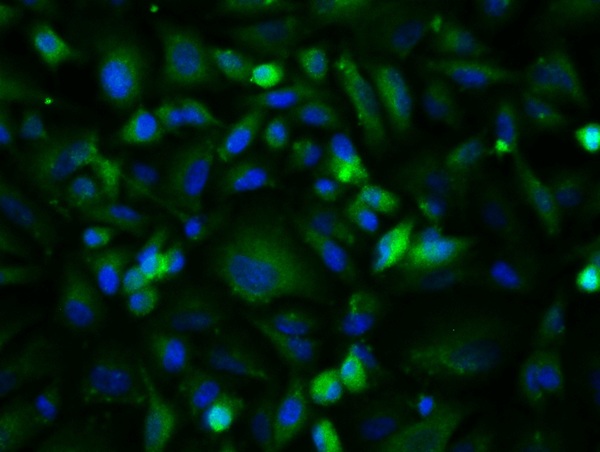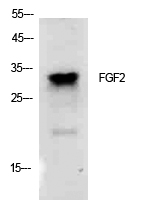FGF2 antibody [AS24]
GTX17279
ApplicationsELISA, ImmunoHistoChemistry, ImmunoHistoChemistry Paraffin
Product group Antibodies
TargetFGF2
Overview
- SupplierGeneTex
- Product NameFGF2 antibody [AS24]
- Delivery Days Customer9
- Application Supplier NoteELISA: This antibody can be used as a coating antibody at 10 microg/ml in a two site ELISA with biotin conjugated bFGF antibody. Typically the ELISA has a working range of 0-2000 pg/ml and a sensitivity of 5 pg/ml with the appropriate standard. Recommended sample volumes are 25-200 microl. Recovery of human basic FGF in human serum is typically > 85% in the ELISA. IHC: This antibody can be used at 1-10 ug/ml to stain human basic FGF expressed in mononuclear cells, following fixation with 4% paraform in PBS for 10minutes at 48C, plus 0.1% saponin for 20minutes at room temperature. Optimal dilutions/concentrations should be determined by the end user.
- ApplicationsELISA, ImmunoHistoChemistry, ImmunoHistoChemistry Paraffin
- CertificationResearch Use Only
- ClonalityMonoclonal
- Clone IDAS24
- Concentration1 mg/ml
- ConjugateUnconjugated
- Gene ID2247
- Target nameFGF2
- Target descriptionfibroblast growth factor 2
- Target synonymsBFGF, FGF-2, FGFB, HBGF-2, fibroblast growth factor 2, basic fibroblast growth factor bFGF, fibroblast growth factor 2 (basic), heparin-binding growth factor 2, prostatropin
- HostMouse
- IsotypeIgG1
- Protein IDP09038
- Protein NameFibroblast growth factor 2
- Scientific DescriptionThe protein encoded by this gene is a member of the fibroblast growth factor (FGF) family. FGF family members bind heparin and possess broad mitogenic and angiogenic activities. This protein has been implicated in diverse biological processes, such as limb and nervous system development, wound healing, and tumor growth. The mRNA for this gene contains multiple polyadenylation sites, and is alternatively translated from non-AUG (CUG) and AUG initiation codons, resulting in five different isoforms with distinct properties. The CUG-initiated isoforms are localized in the nucleus and are responsible for the intracrine effect, whereas, the AUG-initiated form is mostly cytosolic and is responsible for the paracrine and autocrine effects of this FGF. [provided by RefSeq, Jul 2008]
- Storage Instruction-20°C or -80°C,2°C to 8°C
- UNSPSC12352203





![IHC-P analysis of human recturn adenocarcinoma tissue using GTX83243 FGF2 antibody [2H5G2C11].](https://www.genetex.com/upload/website/prouct_img/normal/GTX83243/GTX83243_20170912_IHC-P_w_23061322_867.webp)
![WB analysis of various samples using GTX84501 FGF2 antibody [2H11]. Loading : 10 ug per lane Dilution : 1:200](https://www.genetex.com/upload/website/prouct_img/normal/GTX84501/GTX84501_3537_WB_w_23061420_850.webp)
![ICC/IF analysis of COS7 cells transiently transfected with FGF2 plasmid using GTX84502 FGF2 antibody [3D9].](https://www.genetex.com/upload/website/prouct_img/normal/GTX84502/GTX84502_1110_ICCIF_w_23061420_526.webp)